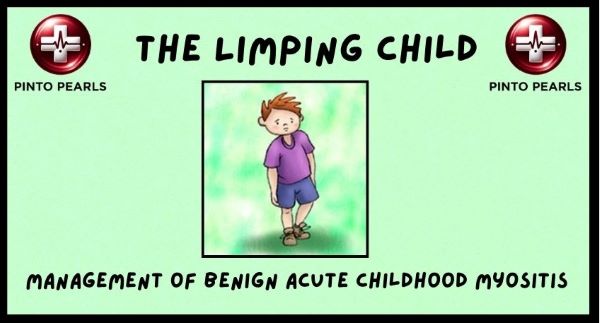

Case: A previously healthy 7-year-old boy presented with a cough, cold, and mild fever for 2 days. Today, the child complains of severe leg pain and refuses to walk. On examination, the child has a fever of 38.7 degrees, normal vital signs, no signs of trauma, no skin changes, and no weakness in the upper or lower extremities. However, the child has bilateral calf tenderness, his feet are in slight plantar flexion, and dorsiflexion of the ankles causes pain. What is the most likely diagnosis?
- Transient Tenosynovitis
- Guillain-Bare Syndrome
- Muscular Dystrophy
- Benign Acute Childhood Myositis
Answer: D Benign Acute Childhood Myositis
Ok doc, What is Benign Acute Childhood Myositis?
Benign Acute Childhood Myositis (BACM) aka Viral Myositis is a self-resolving condition affecting young children and its main symptoms are:
- A sudden onset of bilateral severe muscle pain,
- Primarily in the lower extremities (gastrocnemius or soleus muscles)
- Started after a viral illness.
Who does Benign Acute Childhood Myositis (BACM) tend to affect?
BACM usually affects school-aged children, typically around 6-8 years old and usually more in BOYS, though it can occur in both genders.
How does it present? How is it diagnosed?
- BACM is usually a clinical diagnoses and is based on the clinical presentation of
- History of recent viral infection – Fever, sore throat
- Symmetric bilateral leg / calf pain,
- Often a “stiff legged gait” or hesitant to walk
- Pain is WORSE after rest
- Normal or slightly elevated temperature
Are there any tests that are useful in making this diagnosis?
- Creatinine Kinase (CK) is very useful because it is usually elevated in BACM
- Typical tests to order:
- CBC, Cr, CK, CRP, Urea, Urine analysis
- Note: WBC and platelet counts are typical normal or decreased
- Pro Tip: Check Cr and Urine to make sure the rhabdomyolysis (a complication of BACM) is not also present
- Cr – would be elevated
- Urine – would show signs of myoglobinuria (tea coloured)
- CBC, Cr, CK, CRP, Urea, Urine analysis
But Doc, A child with a limp can have some other scary causes. What are things that should be considered?
- It is crucial to differentiate BACM from other serious conditions of a child with Limp
- The presence of following suggests an alternative diagnosis:
- Positive Family history of neuromuscular disease
- Muscle weakness/ paralysis
- Decreased or absent Deep Tendon reflexes
- Abnormal neurological findings
- Asymmetrical pain
- Recent Trauma
- Skin Changes
Differential Diagnosis

Hey Doc, Transient Synovitis also causes a limp after a febrile illness. What are the main differences between transient synovitis and Benign Acute Childhood Myositis?
- Transient Synovitis is
- UNILATERAL, and
- NO CK involvement
Are there any complications of BACM?
- Complications are quite RARE.
- The most common complication, if there is one, is rhabdomyolysis, and rarely acute kidney injury if the rhabdomyolysis is severe
Ok Doc, so how would you Manage these patients?
- The majority of children recover completely within 3 days ON THEIR OWN, with minimal intervention.
- The important thing is that the child
- Stays hydrated (ie Drink Fluids!)
- Get Pain Medications (Tylenol/ Advil)
Hey Doc, would the child ever need to be admitted?
Hospitalization is rarely needed unless there are concerns about complications, or if the child has risk factors for OTHER causes of illness
Risk factors for potential hospitalization/ complication:
- Age < 2
- Dark Urine/ Signs of Rhabdomyolysis
- Abnormal renal function/ Signs of Acute Kidney Injury
Risk factors for OTHER causes of child with limp (as above)
- Positive Family history of neuromuscular disease
- Muscle weakness/ paralysis
- Decreased or absent Deep Tendon reflexes
- Abnormal neurological findings
- Asymmetrical pain
- Recent Trauma
- Skin Changes
What is the prognosis or outcomes for BACM?
- Prognosis for BACM is Excellent,
- Most children have a full recovery with fluids and pain control
- No long-term effects and recurrence is extremely rare
Take Home Points
- Benign Acute Childhood Myositis (BACM) also known as Viral Myositis is COMMON
- It typically follows a viral infection and tends to occur in BOYS 6 – 8 yrs
- It is SELF RESOLVING majority of the time and just needs Fluids and Pain control
- CK tends to be elevated,
- Complications such as rhabdomyolysis is RARE
- Hospitalization is rarely required and most children are back to normal in a couple of days
References
Brisca, G., Mariani, M., Pirlo, D. et al. Management and outcome of benign acute childhood myositis in pediatric emergency department. Ital J Pediatr 47, 57 (2021).
Magee H, Goldman RD. Viral myositis in children. Can Fam Physician. 2017 May;63(5):365-368.
Skrzypczyk P, Przychodzień J, Pańczyk-Tomaszewska M. Benign acute childhood myositis complicating influenza B infection in a boy with idiopathic nephrotic syndrome. Cent Eur J Immunol. 2016;41(3):328-331.
Terlizzi V, Improta F, Raia V. Simple diagnosis of benign acute childhood myositis: Lessons from a case report. J Pediatr Neurosci.

